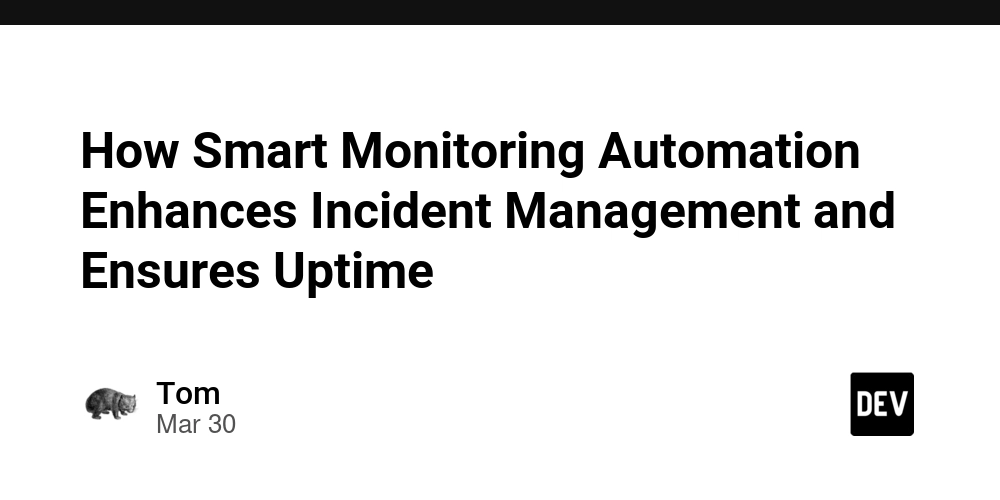How Smart Monitoring Automation Enhances Incident Management and Ensures Uptime
Untitled Remember the last major outage your team handled? The scramble to identify what failed, the frantic Slack messages, the pressure to restore service while executives demand updates? What if your systems could detect, diagnose, and even begin resolving issues before your customers notice anything wrong? That's the promise of smart monitoring automation. Let's dive into how it actually works and what it can do for your incident management process. What is Automated Incident Monitoring? Automated incident monitoring goes beyond basic health checks. It's a comprehensive system that: ┌─────────────────────────────────────────────────┐ │ │ │ ┌─────────┐ ┌──────────┐ ┌────────────┐ │ │ │ Collect │───▶│ Analyze │───▶│ Respond │ │ │ │ Data │ │ Patterns │ │ │ │ │ └─────────┘ └──────────┘ └────────────┘ │ │ ▲ │ │ │ │ │ ▼ ▼ │ │ ┌─────────┐ ┌──────────┐ ┌────────────┐ │ │ │ Service │ │ Alert │◀───│ Trigger │ │ │ │ Metrics │ │ │ │ Actions │ │ │ └─────────┘ └──────────┘ └────────────┘ │ │ │ └─────────────────────────────────────────────────┘ Unlike traditional monitoring that waits for thresholds to be crossed, automated monitoring uses pattern recognition and anomaly detection to identify issues before they become critical failures. Key Components: Real-Time Detection: Continuously analyzing service metrics Anomaly Identification: Finding what's unusual, not just what's broken Automated Response: Taking predefined actions based on specific conditions Intelligent Escalation: Routing issues to the right team members Why Engineers Are Switching to Monitoring Automation Reduced Mean Time to Recovery (MTTR) The math here is simple: Manual Process: Issue occurs → Alert triggers → Engineer sees alert → Investigation begins → Problem identified → Solution implemented Automated Process: Issue pattern detected → Automated diagnostics run → Remediation script executes → Engineer notified of action taken Many standard recovery procedures can be automated, cutting resolution time dramatically: # Example automated recovery script for a stuck process if [[ $(ps aux | grep myservice | wc -l) -lt 2 ]]; then logger "MyService process not found, restarting" systemctl restart myservice curl -X POST $WEBHOOK_URL -d "MyService auto-restarted after process check failure" fi Higher Signal-to-Noise Ratio Traditional monitoring produces alerts like: ALERT: CPU usage > 80% ALERT: Memory usage > 75% ALERT: Disk space 0.6 * max_capacity: # Pre-emptively scale up before hitting limits scale_service(current_capacity * 1.5) notify("Pre-emptive scaling applied based on historical patterns") How to Implement Automated Monitoring Start with Service Mapping Before automating, understand your service dependencies: graph TD A[Frontend] --> B[Auth Service] A --> C[Product Service] C --> D[Inventory DB] C --> E[Pricing Service] E --> F[External Rate API] This mapping helps you identify: Critical paths that need the most monitoring Common failure points Cascading dependency failures Choose the Right Tools Look for platforms that offer: API-first design: Automation requires programmatic access Flexible alerting: Support for complex conditions Integration capabilities: Works with your existing stack Runbook automation: Can trigger remediation scripts Begin with High-Value, Low-Risk Automations Start with automations that have: High frequency (common issues) Clear diagnosis steps Well-understood remediation Low risk if automation fails Good candidates include: Service restarts for known error conditions Auto-scaling based on load metrics Cache clearing procedures Read-only diagnostic data collection Document Everything For each automated workflow, document: - What triggers the automation - What actions it takes - How to verify it worked - How to manually perform the same steps - How to disable the automation if needed Real Examples of Smart Automation in Action Preventing Database Outages A fintech company implemented automated monitoring of their database connection patterns: # PromQL to detect connection pool saturation max_over_time(db_connections_used{service="payment-api"}[5m]) / db_connections_max{service="payment-api"} > 0.85 When connections reached 85% of capacity, their system would: Run diagnostics to identify connection leak sources Temporarily increase the connection pool Notify engineers with diagnostic data Result: Zero customer-facing outages from connection pool exhaustion, down from an aver

Untitled
Remember the last major outage your team handled? The scramble to identify what failed, the frantic Slack messages, the pressure to restore service while executives demand updates?
What if your systems could detect, diagnose, and even begin resolving issues before your customers notice anything wrong?
That's the promise of smart monitoring automation. Let's dive into how it actually works and what it can do for your incident management process.
What is Automated Incident Monitoring?
Automated incident monitoring goes beyond basic health checks. It's a comprehensive system that:
┌─────────────────────────────────────────────────┐
│ │
│ ┌─────────┐ ┌──────────┐ ┌────────────┐ │
│ │ Collect │───▶│ Analyze │───▶│ Respond │ │
│ │ Data │ │ Patterns │ │ │ │
│ └─────────┘ └──────────┘ └────────────┘ │
│ ▲ │ │ │
│ │ ▼ ▼ │
│ ┌─────────┐ ┌──────────┐ ┌────────────┐ │
│ │ Service │ │ Alert │◀───│ Trigger │ │
│ │ Metrics │ │ │ │ Actions │ │
│ └─────────┘ └──────────┘ └────────────┘ │
│ │
└─────────────────────────────────────────────────┘
Unlike traditional monitoring that waits for thresholds to be crossed, automated monitoring uses pattern recognition and anomaly detection to identify issues before they become critical failures.
Key Components:
Real-Time Detection: Continuously analyzing service metrics
Anomaly Identification: Finding what's unusual, not just what's broken
Automated Response: Taking predefined actions based on specific conditions
Intelligent Escalation: Routing issues to the right team members
Why Engineers Are Switching to Monitoring Automation
Reduced Mean Time to Recovery (MTTR)
The math here is simple:
Manual Process:
Issue occurs → Alert triggers → Engineer sees alert →
Investigation begins → Problem identified → Solution implemented
Automated Process:
Issue pattern detected → Automated diagnostics run →
Remediation script executes → Engineer notified of action taken
Many standard recovery procedures can be automated, cutting resolution time dramatically:
# Example automated recovery script for a stuck process
if [[ $(ps aux | grep myservice | wc -l) -lt 2 ]]; then
logger "MyService process not found, restarting"
systemctl restart myservice
curl -X POST $WEBHOOK_URL -d "MyService auto-restarted after process check failure"
fi
Higher Signal-to-Noise Ratio
Traditional monitoring produces alerts like:
ALERT: CPU usage > 80%
ALERT: Memory usage > 75%
ALERT: Disk space < 10%
Smart automation contextualizes these alerts:
INCIDENT: Payment processing delayed
- API latency increased 300% in last 5 minutes
- Database connection pool at capacity
- Recent deployment (v2.4.1) coincides with issue
- 3 similar incidents in last month resolved by scaling connection pool
The difference? Actionable context that speeds up resolution.
Cost Efficiency
Automated incident response reduces costs in several ways:
Less downtime: Faster resolution means less revenue impact
Reduced toil: Engineers spend less time on repetitive tasks
Right-sized on-call: Fewer false alarms means less burnout
Proactive Problem Management
Smart automation moves you from reactive to proactive operations:
# Pseudocode for predictive scaling
def check_historical_patterns():
# Check if today matches a pattern (e.g., end of month)
if is_pattern_day() and current_load > 0.6 * max_capacity:
# Pre-emptively scale up before hitting limits
scale_service(current_capacity * 1.5)
notify("Pre-emptive scaling applied based on historical patterns")
How to Implement Automated Monitoring
Start with Service Mapping
Before automating, understand your service dependencies:
graph TD
A[Frontend] --> B[Auth Service]
A --> C[Product Service]
C --> D[Inventory DB]
C --> E[Pricing Service]
E --> F[External Rate API]
This mapping helps you identify:
Critical paths that need the most monitoring
Common failure points
Cascading dependency failures
Choose the Right Tools
Look for platforms that offer:
API-first design: Automation requires programmatic access
Flexible alerting: Support for complex conditions
Integration capabilities: Works with your existing stack
Runbook automation: Can trigger remediation scripts
Begin with High-Value, Low-Risk Automations
Start with automations that have:
High frequency (common issues)
Clear diagnosis steps
Well-understood remediation
Low risk if automation fails
Good candidates include:
Service restarts for known error conditions
Auto-scaling based on load metrics
Cache clearing procedures
Read-only diagnostic data collection
Document Everything
For each automated workflow, document:
- What triggers the automation
- What actions it takes
- How to verify it worked
- How to manually perform the same steps
- How to disable the automation if needed
Real Examples of Smart Automation in Action
Preventing Database Outages
A fintech company implemented automated monitoring of their database connection patterns:
# PromQL to detect connection pool saturation
max_over_time(db_connections_used{service="payment-api"}[5m])
/
db_connections_max{service="payment-api"} > 0.85
When connections reached 85% of capacity, their system would:
Run diagnostics to identify connection leak sources
Temporarily increase the connection pool
Notify engineers with diagnostic data
Result: Zero customer-facing outages from connection pool exhaustion, down from an average of one per month.
Intelligent Service Scaling
An e-commerce platform automated their scaling based on traffic patterns:
Monitoring detects:
- Checkout latency increasing 5% per minute
- Payment API error rate climbing
- Similar pattern to previous flash sales
Automated response:
- Scales API servers to 2x current capacity
- Increases database connection limit
- Enables enhanced caching layer
- Opens incident channel in Slack with context
Result: Their last flash sale had zero cart abandonment due to system performance, compared to 12% in previous sales.
How Bubobot Simplifies Monitoring Automation
Bubobot provides the essential components for effective incident automation:
Fast detection cycles: Checks as frequent as every 20 seconds
Intelligent alerting: Context-aware notifications that reduce noise
Automation triggers: Webhooks and API integration for custom actions
Comprehensive coverage: Monitor APIs, services, and dependencies
The platform is designed to grow with your automation journey:
Start with basic uptime monitoring
Add smarter alerts and escalation policies
Integrate with your incident management workflow
Implement automated remediation
The Road Ahead: Where Monitoring Automation is Going
The future of incident management is evolving rapidly:
AI-driven root cause analysis: Systems that pinpoint the likely cause based on patterns
Autonomous testing: Automated test suite generation based on incident patterns
Cross-team intelligence: Learning from how other organizations solve similar problems
The Bottom Line
Smart monitoring automation isn't about replacing engineers—it's about letting them focus on complex problems while routine issues are handled automatically.
By implementing progressive automation in your monitoring stack, you can:
Detect issues faster
Respond more consistently
Reduce toil and burnout
Build more reliable systems
The best time to start was yesterday. The second-best time is now.
For a deeper dive into implementing monitoring automation with practical examples, check out our comprehensive guide on the Bubobot blog.




















































%20Abstract%20Background%20112024%20SOURCE%20Amazon.jpg)






















































































































![[The AI Show Episode 142]: ChatGPT’s New Image Generator, Studio Ghibli Craze and Backlash, Gemini 2.5, OpenAI Academy, 4o Updates, Vibe Marketing & xAI Acquires X](https://www.marketingaiinstitute.com/hubfs/ep%20142%20cover.png)
























































































































































































































































-Nintendo-Switch-2-–-Overview-trailer-00-00-10.png?width=1920&height=1920&fit=bounds&quality=80&format=jpg&auto=webp#)





















_Anna_Berkut_Alamy.jpg?#)













































































































![YouTube Announces New Creation Tools for Shorts [Video]](https://www.iclarified.com/images/news/96923/96923/96923-640.jpg)





































































![[Weekly funding roundup March 29-April 4] Steady-state VC inflow pre-empts Trump tariff impact](https://images.yourstory.com/cs/2/220356402d6d11e9aa979329348d4c3e/WeeklyFundingRoundupNewLogo1-1739546168054.jpg)





























































